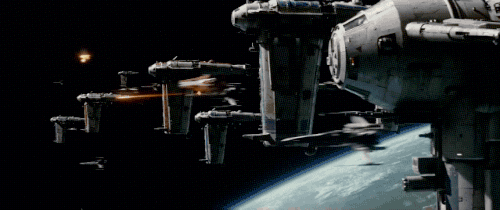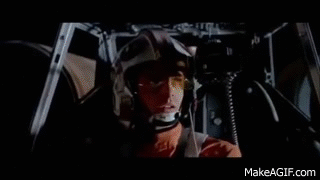In the Great The Last Jedi Wars of 2017, I’m on the “I love this movie” side. Let me get that out of the way first. Writer/director Rian Johnson’s film was, for me, the most thematically rich, best-acted, best-directed, best-looking of all the Star Wars movies. I loved the way it played off and subverted established Star Wars tropes and expectations, from the first scene to the last, while still clearly being built around a deep love of the earlier movies. I’ve seen it four times as of this writing and will be trying to get in at least one more in-theater viewing. For whatever reason, it landed really squarely for me, and is currently my third-favorite of all the Star Wars films, pushing hard for the #2 spot.
So, that’s that part. I’m not interested in rebutting anyone’s complaints–we’re allowed to like different movies, you and I!–nor do I particularly feel like rehashing the moments that worked so well for me. What I do want to look at is one specific subversion of an iconic moment that I haven’t seen directly discussed anywhere, and doing that will necessitate SPOILERS after the jump.
The subversion I’m thinking of actually occurs twice in Last Jedi. The first time is just before the disastrous space battle GIFed above. Poe Dameron (Oscar Isaac), flush with arrogance after a successful individual mission to knock out some surface cannons and buy time for the Resistance evacuation, decides to push on and lead an attack squadron to try and destroy a First Order Dreadnaught cruiser, which he describes as a “fleet killer”.
His commanding officer, General Leia Organa (the late Carrie Fisher) orders him to back off, to return to the fleet and join the retreat … so Poe flips off his communicator, cutting her off mid-sentence. He calls in a bombing squadron, backed by a bunch of the rapidly-dwindling Resistance fighter craft, and they manage to destroy the Dreadnaught only through the barest luck, after taking heavy losses.
The first time you watch Last Jedi, the scene plays as a very traditional Hollywood moment: the brave maverick fighter jock knows better than his commanders, and only his lunatic heroism can save the day. You focus on the victory (“Dreadnaught down!” they yell, as the music swells) and don’t necessarily relate to Leia’s recriminations and reprimanding of Poe.
The same scene is repeated toward the end of the movie, as the last dregs of the Resistance are holed up in a mine on the salt planet of Crait. Thirteen pilots, including Poe and former stormtrooper Finn (John Boyega), are making a last-ditch sortie in rickety old skim speeders, ostensibly to take out a “battering ram cannon,” but more broadly to buy time for a distress signal to reach distant allies. It’s another great bit of updated Star Wars-iana, taking the conceit of space battles being shot like the dogfights in WW2 movies and applying it to the trope of the heroes being forced to use ancient biplanes against modern mechanized infantry.
The relevant moment comes at the last moment. Poe, having learned the lesson of his earlier error (and of the second act of the movie, which is essentially a sustained, extended reinforcement of that same lesson) realizes that they’re all going to get picked off and not accomplish anything, and he calls a retreat. Finn disregards the order and then, in a nice reversal on the earlier scene, flips off his communicator and settles in for a suicide run.
He’s saved only by one of the prevailing themes of the movie, in the form of fellow pilot Rose (Kelly Marie Tran) crashing into him and throwing him out of the line of fire. “That’s how we’re gonna win,” she says, dramatically, between bouts of being unconscious. “Not fighting what we hate. Saving what we love.”
It’s a really economical scene, from a screenwriting perspective. It provides Poe with the crucial moment in his character arc, demonstrated through action; it provides Finn with a major turn in his own arc (two, actually, as he first is demonstrating that his devotion to the Resistance is now complete, that he’s understood THAT part of Rose’s lessons; but also the subsequent turn teaching him the second part); it gives Rose a hero moment AND a dramatic speech; and, via Rose’s speech, it sets up the theme of the next major setpiece, a lightsaber duel in which no lightsabers touch and no one is physically wounded. Oh, and it also turns the screws on the Resistance one more time, sending them down to their final, most hopeless moment. (I know I said I wasn’t gonna do this, but I really, really admire the heck out of this screenplay, you guys.)
But I’m convinced it’s doing one more subtle thing as well. I think all that flipping off of commlinks is a callback to, and subversion of, the ur-Star Wars moment. One of the most foundational scenes of the whole multi-billion dollar enterprise. A scene so iconic that it can even stand on a level with Beyoncé:
Beyonce taking out the earpiece is Luke turning off the targeting system in the Death Star trench.
— BUM CHILLUPS (@edsbs) January 21, 2013
I have this game I play with the original trilogy, where I mentally replace all references to “the Force” with their equivalents in some earthly religion. It’s good mostly just for mild amusement, but that is one specific scene where it changes the tenor of the movie pretty drastically:
Imagine, for a second, the real-world equivalent of this. Some U.S. fighter pilot, let’s say, is making a vital, last-ditch effort to destroy an enemy ICBM launch site. Against all odds, the target is in range … and then he switches his targeting system off and confidently assures mission control that it’s all right, because Jesus will guide his aim.
That … would not play like a hero moment. And I think Johnson has been repeatedly calling back to it for almost exactly that reason.
In an earlier, unrelated scene, Luke excoriates himself for his pride, for believing in his own legend, but he’s mostly referring to his Jedi-level exploits, and to his failure to prevent Ben Solo from turning into the twisted, bitter Kylo Ren (Adam Driver). The simple gesture of Poe and Finn turning off external assistance in their respective fighters is a subtle, graceful reminder that Luke’s greatest success came from exactly that moment–and, by extension, a condemnation of that sort of hero ball.
What’s more, this builds on one quiet side effect of Rogue One (especially if you watch that film as a direct prologue to Episode IV), which I wrote about here almost exactly a year ago:
And when Luke shuts off his targeting computer in the final moments of the attack run, choosing instead to rely on the voices in his head, the emotional stakes of that decision now scan as much, much higher. When watching previously, the entire hero’s journey narrative structure acted to let us know that, yes, this was Luke doing the right thing to fulfill his narrative potential. Especially with the addition of the prequels to the canon, there is no doubt in the power of the Force, or in Luke’s bloodlines. (Stupid midichlorians….)
In light of Rogue One, though, there’s a part of your (irrational, story-loving) brain that’s screaming “No, you fanatical lunatic, this is no time for showboating–don’t you know how many people died to create that target for you?” It makes Luke’s little “holy crap” gasp as the torpedoes go in resonate much, much more.
Luke’s moment in the trench (“His computer’s off. Luke, you switched off your targeting computer. What’s wrong?”), arguably the most thrilling moment in the original movie, after having its stakes increased by Rogue One, is now laid bare as absolutely the wrong thing for people to do most of the time. This is, to me, a genuinely daring, almost thrilling, change in the way to view the original trilogy.
And I don’t feel it in any way undermines it or takes away from what the heroes do there. But it, along with the underlying message of The Last Jedi, does all extend from one simple fact (without calling too much attention to it): that ur-hero moment did nothing. The very next movie sees the Rebels being hounded across the galaxy. The movie after that shows that blowing up the Death Star, as great as it felt in that moment, didn’t accomplish anything, because there’s another Death Star right there. The movie after that shows the whole cycle repeating again decades later.
And what Johnson is saying here, mostly through visual language and extrapolation and allusion, is that the only way to break that cycle is to point out that the old ways didn’t work, and to try to find something new. Something new that start with not switching the commlink off. That’s how we’re gonna win, the movie seems to be saying. Not by fighting what we hate, but by actually listening to each other.




Loved this little write-up, Matt.
I like your analysis of the subversive scenes in Last Jedi, but the movie as a whole repeatedly undermines these scenes, especially with the last image we are left with. Poe, Finn, and Rose’s renegade FUBAR mission, which they did not communicate to Holdo, is redeemed by spreading hope and legend, the only currencies that matter in Star Wars.
Initially, you see the lives lost due to reckless heroics as a bad thing, but utimately, they subvert the subversion. I don’t really see this as definitively breaking the cycle in a meaningful way, but I guess that remains to be seen! It was a kind of muddled middle movie for me, but there was a lot to unpack and a lot to like.
Awesome analysis, very insightful. I dug the movie a lot, too, but I didn’t catch most of these connections and allusions that you have nicely ferreted out… You’ve succeeded in making me want to see the film again! Great stuff, Matt!